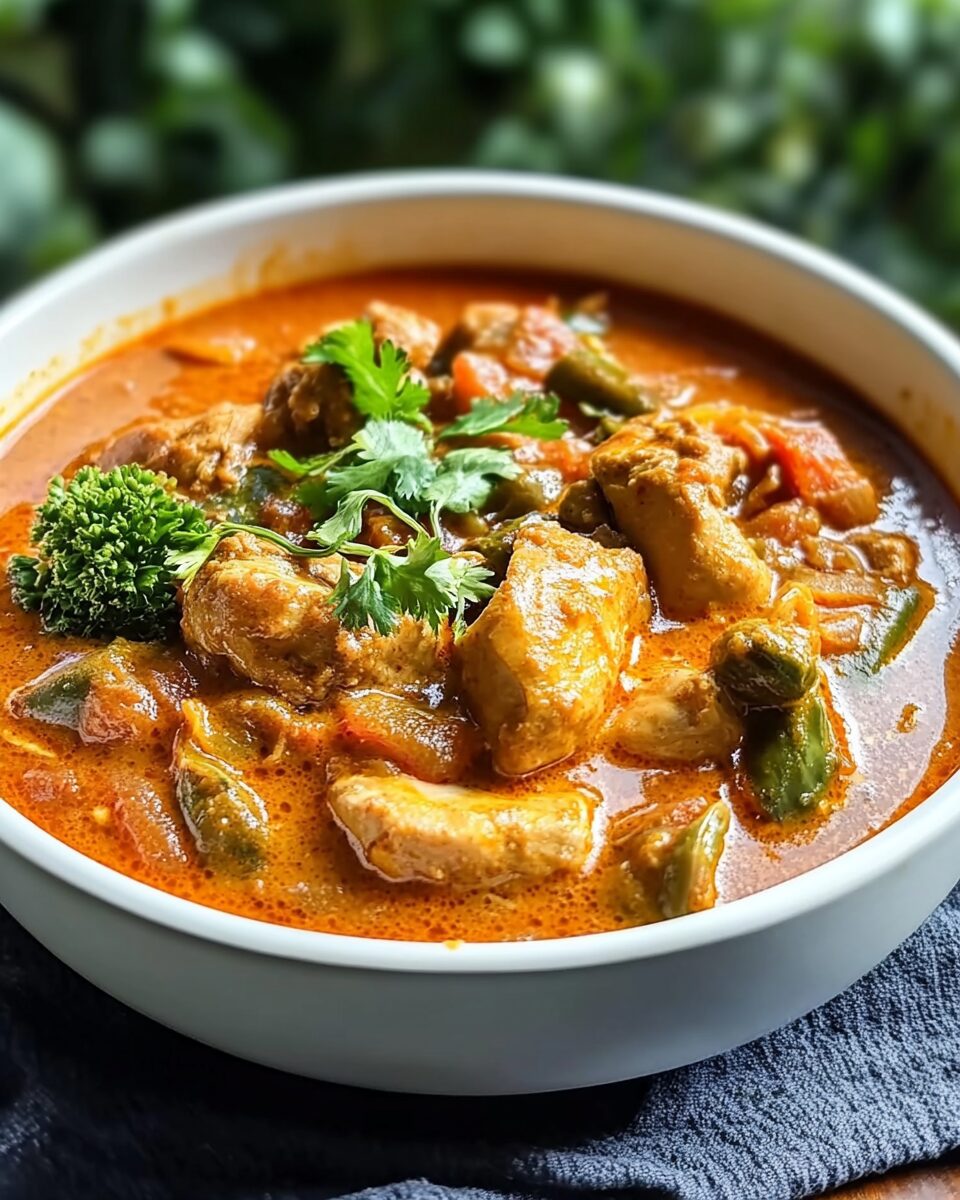This Ethiopian-inspired chicken curry blends the bold heat of Berbere spice with a creamy, savory sauce. The dish delivers rich, aromatic flavor with a hint of sweetness from onions and tomatoes, balanced by the warmth of exotic spices. It’s perfect served over rice or with flatbread for a hearty dinner.
FULL RECIPE
Ingredients
- 1½ lbs boneless, skinless chicken thighs, cut into bite-sized pieces
- 2 tablespoons Berbere spice blend
- 1 tablespoon olive oil
- 1 large onion, finely chopped
- 3 garlic cloves, minced
- 1 tablespoon fresh ginger, grated
- 1 cup canned crushed tomatoes
- ½ cup chicken broth
- ¾ cup heavy cream or coconut cream
- Salt to taste
- Fresh cilantro for garnish (optional)
Directions
- Heat olive oil in a large skillet over medium heat.
- Add chopped onions and sauté until soft and golden, about 5–7 minutes.
- Stir in garlic and ginger; cook for 1 minute until fragrant.
- Add the Berbere spice and toast for 30 seconds to release its aroma.
- Add chicken pieces to the pan and stir to coat with the spices.
- Cook until the chicken is lightly browned on all sides, about 5–6 minutes.
- Pour in the crushed tomatoes and chicken broth, stirring to combine.
- Reduce heat to low, cover, and simmer for 15–20 minutes, or until chicken is cooked through.
- Stir in the cream and let simmer uncovered for 5 minutes to thicken slightly.
- Taste and adjust salt as needed.
- Garnish with fresh cilantro if desired and serve hot.
Nutritional Information
- Calories: 390
- Protein: 30g
- Fat: 25g
- Saturated Fat: 12g
- Carbohydrates: 10g
- Fiber: 2g
- Sugar: 4g
- Sodium: 580mg
Cultural Significance of Berbere
Berbere is at the heart of Ethiopian cuisine and is considered more than just a spice—it’s a cultural expression. This complex blend often includes chili peppers, garlic, ginger, basil, korarima, rue, ajwain, and fenugreek, among other spices. Used extensively in stews, soups, and meats, Berbere represents the deep, layered flavors of Ethiopian culinary tradition, often passed down through generations.
Flavor Profile of the Dish
Ethiopian Berbere Creamy Chicken Curry offers a bold and layered taste experience. The spicy heat from the Berbere is balanced by the creamy base, creating a harmonious flavor that is both comforting and exciting. The sauce is rich and slightly tangy, with aromatic undertones from garlic, onions, and ginger enhancing every bite.
Ideal Serving Suggestions
This dish is best served over fluffy white rice, fragrant basmati, or traditional Ethiopian injera. For a complete meal, pair it with sautéed greens, lentils, or a cooling yogurt side. The curry also goes well with flatbreads such as naan or pita for dipping into the luscious sauce.
Cooking Tips and Techniques
To develop the flavors fully, sauté the onions slowly until they are deeply golden, which brings sweetness and depth to the base. Toasting the Berbere spice briefly in oil before adding liquids helps unlock its aromatic oils, intensifying the flavor. Simmering the curry gently ensures the chicken remains tender and moist.
Customization Options
While the base recipe uses chicken thighs for their rich texture and flavor, you can substitute with chicken breast, lamb, or even tofu for a vegetarian alternative. For a dairy-free version, coconut cream can replace heavy cream without sacrificing richness. Adjusting the amount of Berbere allows control over the spice level for milder or spicier preferences.
Nutritional Highlights
This dish provides a good source of protein and healthy fats. The inclusion of garlic, ginger, and spices contributes to its antioxidant and anti-inflammatory properties. Using coconut cream instead of dairy adds medium-chain triglycerides (MCTs), which may support metabolism and energy levels.
Meal Prep and Storage
Ethiopian Berbere Creamy Chicken Curry stores well and even improves in flavor after a day in the fridge. It’s ideal for batch cooking and meal prep. Store in an airtight container for up to four days or freeze in individual portions for quick reheating on busy days.
Spice Level and Adjustments
Berbere can be quite spicy depending on the blend. If you’re sensitive to heat, start with a smaller amount and build up to your desired intensity. You can also mellow the dish further by adding more cream or a touch of honey to counterbalance the spice.
Pairing with Drinks
For a balanced meal experience, consider pairing this dish with refreshing drinks. A chilled mango lassi, cucumber water, or a light white wine like Riesling complements the spicy richness well. Avoid heavily tannic or bitter beverages, which may compete with the curry’s flavors.
Global Appeal
Though rooted in Ethiopian culture, this curry has global appeal due to its rich flavor, ease of preparation, and flexibility. As people explore international cuisines at home, dishes like this showcase how traditional flavors can be enjoyed worldwide without compromising authenticity.
Dietary Adaptations
This curry can be adapted for various diets. It’s naturally gluten-free and can be made keto-friendly by using coconut cream and serving with low-carb vegetables. For paleo diets, simply avoid dairy and opt for clean protein and whole ingredients.
Origins of the Recipe Fusion
The combination of Berbere with a creamy curry sauce reflects a fusion of traditional Ethiopian spices with global curry techniques. While traditional Ethiopian dishes like Doro Wat use Berbere, this creamy variation integrates cooking methods common in Indian or Western cuisines, creating a unique cross-cultural dish.
Cooking for Crowds
This recipe is easily scalable for gatherings or events. Simply double or triple the ingredients while maintaining the same steps. A large pot or Dutch oven works well to manage volume while ensuring even cooking and distribution of spices.
Sourcing Berbere Spice
Berbere can be found at international or specialty spice shops, or you can make it at home by blending your own mix of spices. The flavor may vary slightly between sources, so it’s worth tasting and adjusting to suit your preference. Freshly ground spices yield the most aromatic and potent results.
Presentation Ideas
For a beautiful presentation, garnish with a swirl of cream or coconut milk and sprinkle with chopped cilantro or parsley. Serve in a wide bowl to highlight the vibrant red-orange hue of the sauce, and consider adding a side of pickled vegetables for a splash of contrast.
Kids and Spice Sensitivity
For families with young children or those sensitive to spice, consider dividing the sauce base and preparing a mild version separately. Berbere’s heat can be intense for some, so offering a side of plain yogurt or avocado can help balance the flavor and reduce the spice for young palates.
Cooking Time Breakdown
From start to finish, this dish typically takes about 40–45 minutes. Prep time is roughly 10–15 minutes for chopping and measuring, while cooking takes about 30 minutes. It’s efficient enough for a weeknight meal yet flavorful enough for special occasions.
Popularity in Modern Cuisine
As interest in African cuisines continues to grow, Ethiopian dishes like this creamy Berbere chicken are gaining traction in global kitchens. Food bloggers, chefs, and home cooks alike are embracing these bold flavors as they seek out diverse and exciting meal options.
Sustainability Considerations
Using chicken thighs not only adds flavor but is also more sustainable than many premium cuts. Choosing locally sourced ingredients, organic spices, and sustainable chicken helps minimize environmental impact and supports ethical farming practices.
Conclusion
Ethiopian Berbere Creamy Chicken Curry is more than just a delicious dish—it’s a culinary bridge between cultures, combining deep Ethiopian spice tradition with a creamy, universally loved curry style. Its adaptability, rich flavor, and wholesome ingredients make it an excellent choice for both adventurous eaters and comfort food lovers alike. Whether you’re introducing Ethiopian flavors to your kitchen for the first time or adding a new favorite to your dinner rotation, this dish delivers a satisfying experience that celebrates bold taste and simple preparation.






